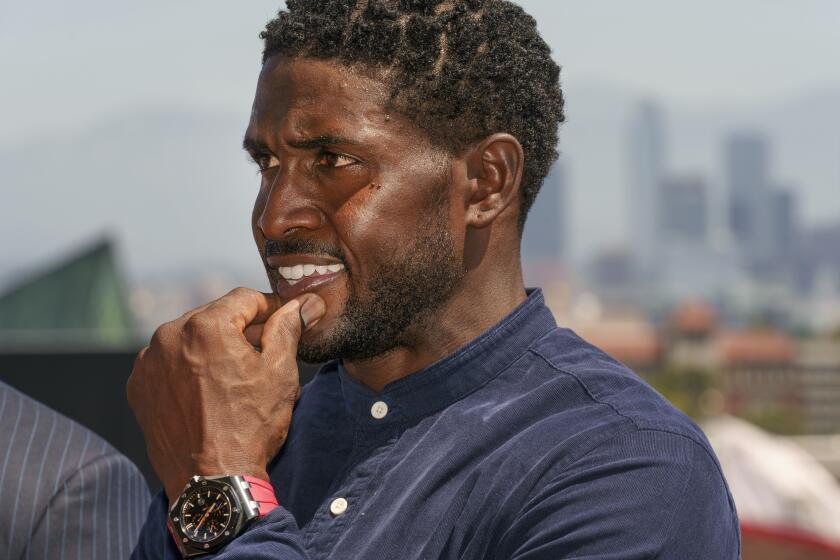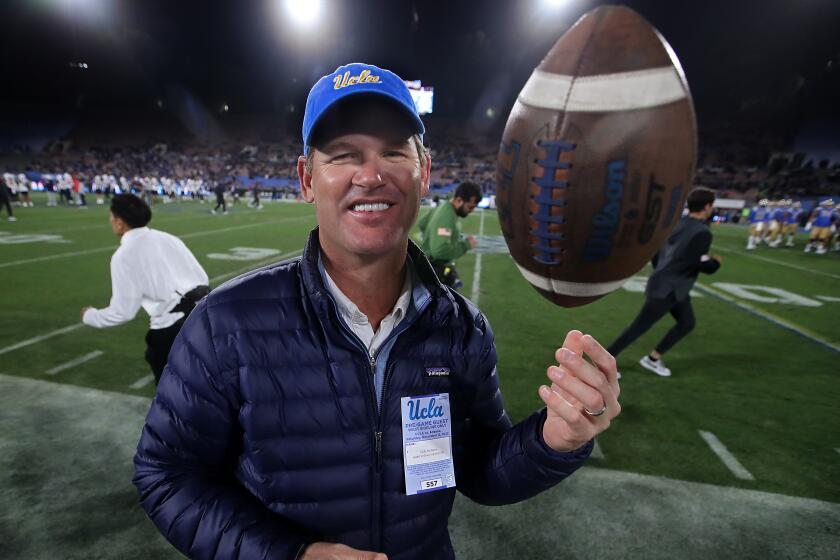Taking the hits for a shot at glory
John Manoogian surveys the line of scrimmage, the noise rising to ear-splitting decibels. He motions to his left, correcting a receiver lined up in the wrong spot, then cups his hands around his mouth and barks orders to the running back on his right.
“Red 13!” Manoogian yells, simulating a change in the play. “Red 13!”
More than 1,000 pounds of USC defensive linemen, some of them bound for next year’s NFL draft, are poised to pounce at the stocky quarterback. But Manoogian receives the snap from center and, as cool as the early-morning mist that shrouds the field, sidesteps the onslaught, throwing the ball downfield just like Oregon quarterback Darron Thomas.
Manoogian completes the pass. More important, he and his band of mostly undersized non-scholarship players -- “walk-ons” as they’re commonly called -- have accurately emulated the Trojans’ next opponent.
“Way to go, babe,” assistant coach Ed Orgeron shouts as the piped-in crowd noise is turned off, “way to go!”
Manoogian has zipped thousands of passes -- “thousands and thousands and thousands,” he says -- during his four years at USC, many while acting as someone else.
He has been Andrew Luck, the Stanford star who is among the front-runners for this year’s Heisman Trophy. He has been Jake Locker, the former Washington star who was a first-round NFL draft pick.
Football fans might pretend they are a star quarterback in a video game, but Manoogian, who played eight-man football at Windward School in Los Angeles, passed up Ivy League opportunities for a real-life fantasy football experience at USC.
“It’s just a great place to say you’ve played,” Manoogian says, “even if you never got on the field.”
Until a few weeks ago, that’s where Manoogian’s career stood.
Then, with the Trojans up big and less than two minutes remaining in a game at Colorado, Coach Lane Kiffin called for No. 18. Quarterback Matt Barkley was coming out after passing for a school-record six touchdowns. The veteran benchwarmer was going in.
As Manoogian received final instructions, a murmur rose from the Trojans’ sideline. “Manooooog.” That grew into a chorus of shouts -- “Manoooooooog!” -- from star players and walk-ons alike as he ran toward the huddle.
“I didn’t know if it was ever going to happen,” he says, “and it finally did.”
Most major college football teams have more than 100 players on their rosters. NCAA rules allow for a maximum of 85 scholarships, so coaches fill holes with players who are smaller or a step slower, young men willing to put their bodies on the line for a place on the team.
USC usually schedules two tryouts a year for walk-ons, one at the beginning of spring practice and another, if necessary, after training camp in the summer. Anyone who makes the cut is expected to attend every practice, team meeting and film session, plus all conditioning and weight training workouts.
The tangible benefits enjoyed by scholarship players are not there for walk-ons. They receive no money for tuition, rent or living expenses. If they eat in the team dining hall, they must pay for their meal. And, in most cases, they can expect little or no playing time.
Instead, they are rewarded with bruises from a steady diet of full-speed practice collisions with future NFL players.
So why do it?
For some, it’s in their genes.
Defensive back Taylor Ashton’s brother, Collin, was a walk-on linebacker who eventually earned a scholarship and started several games for USC’s 2003 national championship team. Receiver Cody Gifford’s father, Frank, was a USC All-American and is in the Pro Football Hall of Fame.
“My dad just bled cardinal and gold,” Gifford says.
For others, it’s the fulfillment of a dream.
Lineman Peter Yobo grew up in Ghana. He never played football but wanted to become a Trojan after watching a short television clip in 2005 of USC and Reggie Bush.
“The feeling is awesome,” Yobo says. “Just being part of that family.”
Small milestones along the way validate the experience and keep walk-ons motivated. It could be as simple as traveling with the team to a road game, when conference rules limit rosters to 70 players, leaving dozens behind.
But as linebacker Augusto Alonso says, “The dream of every walk-on is to get in the game.”
When it happens -- Alonso played against Colorado; Ashton the next week against Washington -- everyone rejoices.
“They work so hard and kind of get their butts kicked every once in a while,” says Matt Kalil, an offensive lineman who is projected to be one of the first players selected in the next NFL draft. “The whole team understands that it’s a big deal.”
Every walk-on has a welcome-to-USC moment when he faces the reality of his endeavor head-on. Boomer Roepke’s came on his first day of practice in 2009, when the former USC swimmer found himself matched against All-American safety Taylor Mays in a one-on-one drill. A coach tossed a ball to the 5-foot-8 Roepke and, a split-second after he caught it, the 6-3, 240-pound Mays blasted into him.
The jolt launched Roepke backward, unbuckled his chin strap and sent his helmet flying off his head. “Oh my God!’ he recalls thinking to himself. “That’s USC football!”
Now Roepke is a staple of the “service team,” made up of walk-ons and reserves. He was in for a kickoff against California and for a play against Colorado, but his main responsibility is to give the front-line players a preview of the upcoming opponent.
“I don’t know that there’s a more important period of practice,” defensive line coach Orgeron says. “And the service-team guys know that.”
At a recent practice, Roepke, Manoogian and other service-team members gathered around Orgeron as the coach held up a large card with a diagramed play and gave the unit instructions.
After a few missteps, Orgeron, already out of patience, menacingly mixed adjectives and expletives. “You don’t run an offense like that!” he shouted, veins rising in his neck, “Run the play!”
When they did, he offered praise.
“Here we go, babe, here we go,” Orgeron said, clapping. “Nice job.”
On an adjoining field, linebacker Alonso worked against the first-team offense. In each of the previous two weeks, his work during practice had been acknowledged with the chance to get in for a few plays at the end of games.
That fulfilled a dream for the Nebraska native, who came to USC on an academic scholarship after getting a perfect score on an aptitude test. Alonso was a finalist for a Rhodes Scholarship, an international postgraduate program at the University of Oxford in England, so he missed the game at Oregon last Saturday because of an interview in Colorado Springs.
A senior, he knows he might never play another snap for the Trojans -- USC ends its season Saturday night when it plays host to UCLA at the Coliseum -- and he is fine with that. “Everything we’ve done, for those six plays I was out there, was 100% worth it,” he says of the Colorado game. “Every single second of it.”
Manoogian can relate. He became a strong-armed leader of the service team while helping younger teammates learn the offense.
“It’s like he’s been a playing quarterback in college for 10 years,” Kiffin says. So the head coach didn’t issue any special instructions before sending Manoogian in against Colorado. He told him the play and watched him run onto the field.
“I was so stoked for him,” Barkley says.
There was nothing spectacular about Manoogian’s performance: He handed off the ball twice and pitched it once to a running back as USC ran out the clock.
But walking off the field after the game, Manoogian enjoyed a different kind of highlight, spying his beaming father in the stands.
“You never know what’s going to happen,” the quarterback says later. “You just have to stay ready and hope your chance comes.”
Manoogian is not expecting another opportunity, but if one presents itself he hopes to reach another level.
Maybe, just maybe, they will let him throw a pass.
--
twitter.com/latimesklein
Go beyond the scoreboard
Get the latest on L.A.'s teams in the daily Sports Report newsletter.
You may occasionally receive promotional content from the Los Angeles Times.




